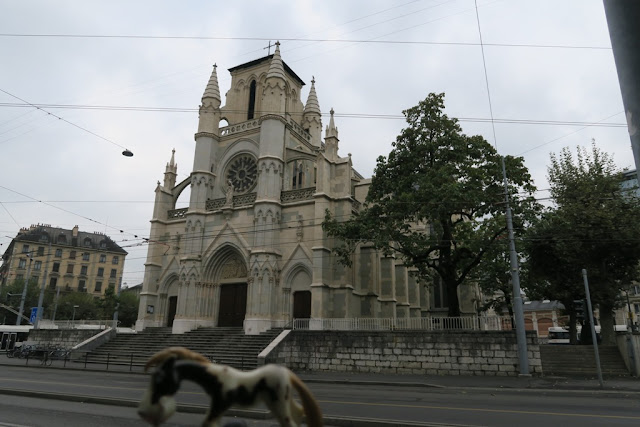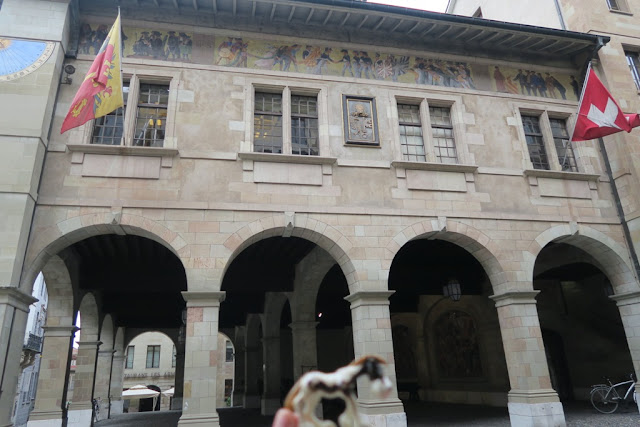Actually in our hotel I have seen people from Northern part of Switzerland talking to the receptionist in English! They did not speak French and the receptionist did not speak German, so even though they were all coming from the same country, they had to use a language that was foreign to all of them.
But as a matter of fact, Geneva is one of the most cosmopolitan cities in Europe. It is said that over fifty percent of the inhabitants hold a foreign passport. This will not be so surprising if you realise, that Geneva is the seat of many international organisations, like the International Red Cross and Red Crescent Movement.
Geneva houses also the European headquarters of the United Nations.
Opposite to it, on the Place of the Nations, you can see a huge chair with one broken leg. It was designed to help politicians visualise the effects of land mines and cluster bombs, and thus put some pressure on UNO to ban them completely.
Another truly international organisation in Geneva is the European Organization for Nuclear Research, better known as CERN.
If this building does not ring a bell, I bet this one does. It is called The Globe of Science and Innovation and is in fact a type of museum. Unfortunately it undergoes now some reconstructions and the exhibitions are largely not accessible.
Of course, the history of Geneva dates many centuries back, before anybody would think that it is Earth going around the Sun (not mentioning the Large Hadron Collider). So let's get back to the Old Town.
Geneva had its own bishop in year 379. Hands up those whose countries were Christian at that time. I do not see too many hands ... The city is nowadays protestant, the most important catholic church is the Cathedral of Our Lady of Geneva, build in the middle of the nineteenth century.
The Cathedral of Saint Peter, built somewhere in the twelve century, is now a protestant church.
Still, you will find next to it signs leading to Santiago de Compostela.
Inside, the cathedral is modest.
This is due to the fact that not only it is a protestant church - the Protestant Church of Geneva as a wing of the Calvinism, so a branch of the church that is known for simple, unadorned churches. Actually, John Calvin himself was teaching in the Geneva cathedral, you can still see his chair.
One of the great things about the St. Pierre Cathedral is that it is possible to climb up the towers. We did it
recently in Bardejov, but there only one tower was possible to be climbed. From the top you can see a panorama of the city ...
... and the cathedral itself.
If you look well, you can spot one of the biggest tourist attractions of Geneva. If you missed it, no worries, I will take you there in a few minutes.
Just before we leave, we need to quickly sneak into a little chapel, called Maccabees Chapel, next to the main entry. Very much different from the rest of the church.
Before we leave the Old Town, I will quickly show you two more buildings. The first one is the Arsenal, currently siege of the National Archives. It is nicely decorated and you can see some real cannons below the arcades.
Just on the other side of the street, you can see the Town Hall. The flags of Switzerland and Geneva are hanging every few meters.
Let's now leave the Old Town and go down the hill. We need to pay a tribute to the Reformation Wall.
It was built in 1909 and literally embedded into the city walls of Geneva, to highlight the importance of the city for the Reformation and the importance of Reformation to the city. The triggering event was 400th birth anniversary of Calvin, who amongst others founded the University of Geneva. You will find him here - second from the left.
As we go out of the park, you can take a look at the Grand Théâtre de Genève, so the local opera house. For me, it looks like a smaller version of Opera Bastille. But Geneva is still lucky to have one. In the seventeenth and (partly) eighteenth century the Calvinist influences made the city refuse the creation of an opera house.
Now we have visited the almost all tourist attractions of Geneva. Yes, I remember that I promised you something more. Here it comes - the Jet d'Eau. It is 140 meters high, sending up five hundred litres of water every second, at a speed of two hundred km/h.
Jet d'Eau is only open when the weather conditions are favourable. In case you are unlucky when you come to the city, you may take a glimpse at this video (in French of course!)
Alright, it is time to go now. So says the flower clock so it has to be true. I hope that you have enjoyed the visit.























najbardziej spodobały mi się widoki z góry na dachy miasta, niesamowicie to wygląda! nie miałam też pojęcia, że istnieje coś takiego jak krzesło Kalwina :D
ReplyDelete